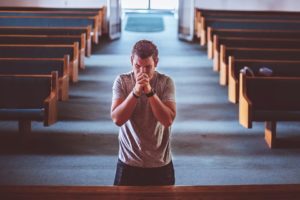 As we look toward Christmas and ponder the incarnation, we ought to remember that so profound was truth of the incarnation that the early Church fell to her knees at these words: “and He was incarnate by the Holy Spirit, from the virgin Mary, and became man.” This act of falling to one’s knees at these words is still practiced in the extraordinary form of the Roman Rite; in the ordinary form, we are asked to bow.
As we look toward Christmas and ponder the incarnation, we ought to remember that so profound was truth of the incarnation that the early Church fell to her knees at these words: “and He was incarnate by the Holy Spirit, from the virgin Mary, and became man.” This act of falling to one’s knees at these words is still practiced in the extraordinary form of the Roman Rite; in the ordinary form, we are asked to bow.
These gestures acknowledge the profound mystery of the truth of the Incarnation. How does the infinite enter the finite? How does He, whom the very heavens cannot contain, enter the womb of Mary. How can He, who holds all creation together in Himself, be held in Mary’s arms?
In modern times we tend to trivialize God. In this age of empiricism and science we want to fit Him into our categories. But God is not just one more thing in the universe (even if very big or powerful) — He is existence itself. Our feeble words betray more than bespeak Him. We know Him as unknown. Our words about Him, even if true, say more about what He is not than what He is.
To some degree the ancients grasped this better than we; they remained astounded at things like the Incarnation. We avoid the tension of this deep mystery by sentimentalizing it. We speak of “the baby Jesus” and sing sentimental songs. This is not wrong, but one wonders if we do this to avoid the astounding mystery and the tension that such mysteries and imponderables summon.
In a passage we read this week in the Office of Readings, St. Gregory Nazianzen wrote of this mystery:
The very Son of God, older than the ages, the invisible, the incomprehensible, the incorporeal, the beginning of beginning, the light of light, the fountain of life and immortality, the image of the archetype, the immovable seal, the perfect likeness, the definition and word of the Father: he it is who comes to his own image and takes our nature for the good of our nature, and unites himself to an intelligent soul for the good of my soul, to purify like by like. He takes to himself all that is human, except for sin …. He who makes rich is made poor; he takes on the poverty of my flesh, that I may gain the riches of his divinity. He who is full is made empty; he is emptied for a brief space of his glory, that I may share in his fullness. What is this wealth of goodness? What is this mystery that surrounds me? (Sermon, Oratio, 49)
We must all fall silent during Advent to ponder such things. There is a place for sentimentality, but wonder and awe — even shock — should also bring us to our knees. The cooing and crying of the little Infant is the same voice, the same Word that summoned creation into existence. It is an ineffable mystery, an unfathomable truth. And this Eternal Word made Flesh brings gifts to us at Christmas’ approach. An old song by St. Ambrose says,
O equal to thy Father, Thou,
Gird on thy fleshly mantle now
The weakness of our mortal state
With deathless might invigorate.
Hush, fall silent before the mystery; less analysis and more wonder and awe.

We don’t live in an age of empiricism, we live in the Messianic Age. Have hope in Christ, Who conquers hearts and the world.
DECEMBER 6, 2017
Charles Coulombe could have said that there are no physically visible cases of the baptism of desire
Charles Coulombe theologically says that there is no baptism of desire but he could simply just say that there are no physically known cases of the baptism of desire in our reality.There is no known case of someone saved outside the Church. Physically we cannot see a person saved outside the Church as Pope Benedict XVI suggested we could in March 2016.Theoretically we can speculate on the baptism of desire but in real life there are none.
He does not even mention this in the video.(6:20) Fr.Leonard Feeney was not teaching heresy since there are no visible cases of the baptism of desire.It does not exist in our reality for it to be relevant or an exception to the dogma extra ecclesiam nulla salus(EENS).
Charles Coulombe wrote a book on the baptism of desire but did not know that there are no physical cases ? Without physical cases there can be no exceptions to EENS.
(10.22) Fr.Leonard Feeney was not asked to recant since the Holy Office 1949 and the archbishop of Boston Richard Cushing had made the error.They presumed that there were physically visible cases of the baptism of desire, as if they could meet and shake hands with someone saved outside the Church.
He was silenced but not answered since the Magisterium had no answer.The Magisterium had made a mistake.-Lionel Andrades
“Hush, fall silent before the mystery; less analysis and more wonder and awe.”
O, that we return to HIM in awe:
Restored during Advent, and continue as a perpetual signature of our relationship with HIM!…